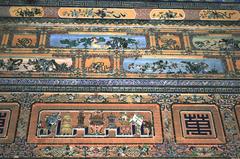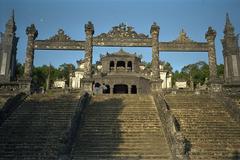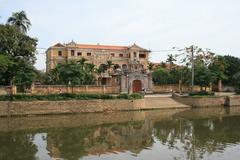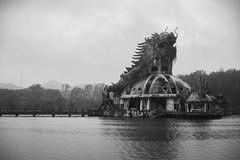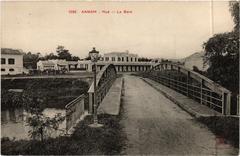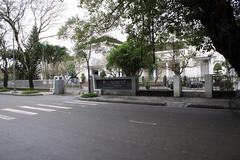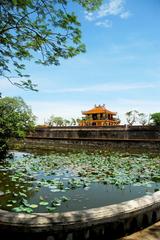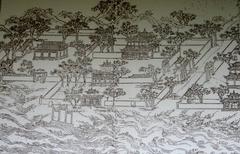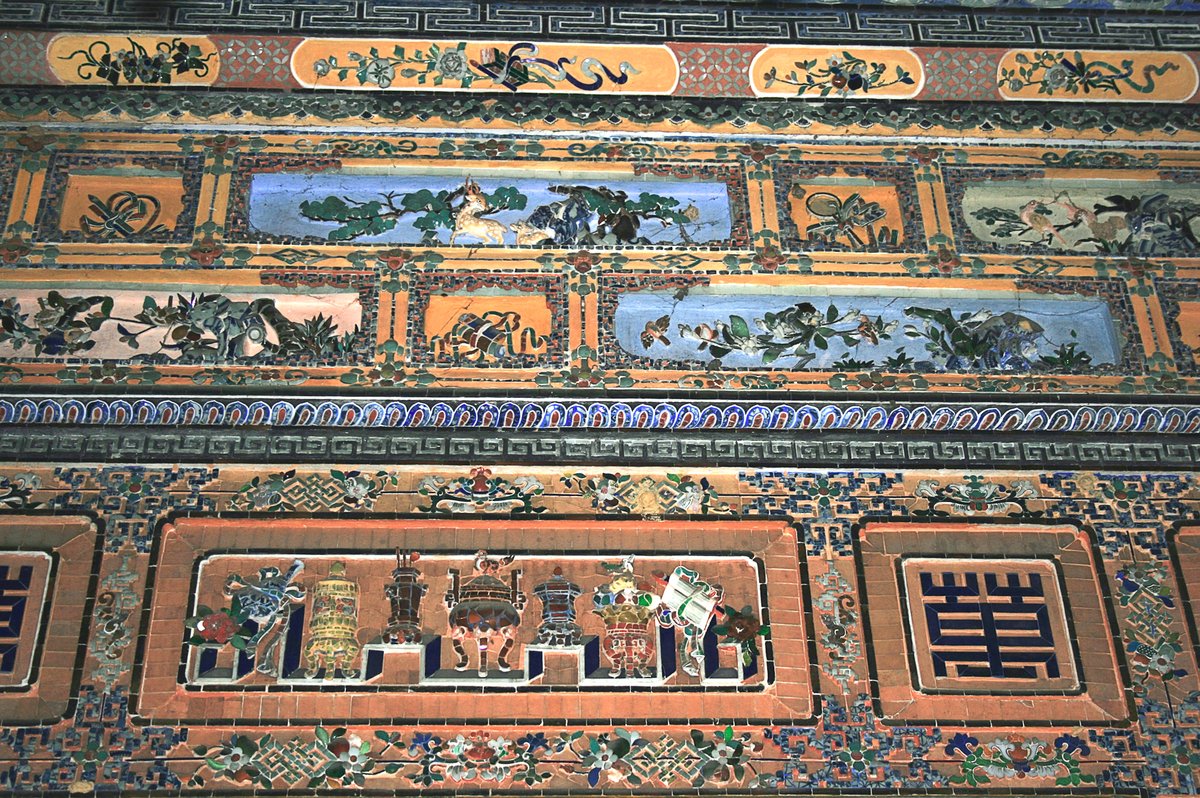
Visiting the Tomb of Khai Dinh in Hue, Vietnam: Complete Guide to Hours, Tickets, and Nearby Attractions
Date: 14/06/2025
Introduction: History and Cultural Importance
Nestled on the slopes of Chau Chu Mountain, just southwest of Huế, the Tomb of Khai Dinh (Ứng Mausoleum) stands as a striking monument to Vietnam’s early 20th-century cultural crossroads. Commissioned by Emperor Khải Định, who ruled from 1916 to 1925, this mausoleum uniquely fuses traditional Vietnamese architecture with European styles—including Baroque, Gothic, and Neoclassical influences. Constructed over 11 years (1920–1931), the tomb encapsulates both personal imperial ambition and the larger colonial context of the era, marked by French influence and modernization (Vietnam Tourism).
Strategically placed about 10 kilometers from Huế’s city center, the tomb’s site was chosen for its auspicious geomantic qualities, symbolizing harmony with its surroundings. Its elaborate design features thousands of porcelain shards, glass mosaics, and materials imported from France, China, and Japan. Since 1993, the Tomb of Khai Dinh has been recognized as a UNESCO World Heritage Site, captivating historians, architects, and travelers from around the globe (UNESCO World Heritage).
This comprehensive guide details visiting hours, ticketing, accessibility, nearby attractions, and expert tips—ensuring you experience the tomb’s historical significance and artistic grandeur to the fullest. Whether you’re a history enthusiast, culture lover, or architectural admirer, understanding the context and visitor logistics will enrich your journey to one of Hue’s most remarkable imperial sites.
Table of Contents
- Introduction
- Origins and Construction
- Architectural Features and Symbolism
- Historical Context and Colonial Influence
- Artistic and Cultural Significance
- Preservation and World Heritage Status
- Practical Visitor Information: Hours, Tickets, Accessibility
- Nearby Attractions in Hue
- Special Events and Photographic Highlights
- Visuals and Media
- FAQs
- Conclusion
Origins and Construction
The Tomb of Khai Dinh is the final resting place of the twelfth Nguyen emperor. Construction began in 1920 and was completed in 1931, six years after the emperor’s death. The site selection, on the slope of Châu Chữ Mountain, followed principles of Vietnamese geomancy, ensuring harmony between the tomb and its environment (Vietnam Tourism).
Unlike previous Nguyen tombs that blended into natural landscapes, Khai Dinh’s mausoleum is notable for its grandeur and its blend of Eastern and Western styles. The tomb features materials such as iron, steel, slate, and colored glass imported from abroad, reflecting the cosmopolitan tastes and the influence of French colonialism (UNESCO).
Architectural Features and Symbolism
Ascending 127 majestic steps, visitors are greeted by stone dragons—emblems of imperial power. The weathered dark concrete exterior gives the tomb a somber, Gothic presence.
Inside, Thien Dinh Palace dazzles with intricate murals, vibrant mosaics, and gilded ornamentation. The ceiling mural—nine dragons amidst swirling clouds—is a symbol of the emperor’s divine right. At the heart of the palace, a bronze statue of Khai Dinh sits above his sarcophagus, framed by lavish artistry. The use of reinforced concrete enabled unprecedented decorative complexity, setting this tomb apart from its predecessors (Atlas Obscura).
The blending of Vietnamese and European elements is a testament to Khai Dinh’s efforts to assert imperial legitimacy and embrace modernity in a colonial context.
Historical Context and Colonial Influence
Khai Dinh’s reign unfolded during the height of French colonial rule. Unlike his predecessors, he was perceived as a collaborator with the French, a stance reflected in both his legacy and the tomb’s design. The tomb’s construction, funded by increased taxation, was controversial and contributed to Khai Dinh’s complex reputation. Nevertheless, the mausoleum stands as a monument to a transformative era in Vietnamese history (Lonely Planet).
Artistic and Cultural Significance
The tomb’s artistic program—crafted by artisans from across Vietnam—combines regional styles and techniques. The mosaics, made from thousands of porcelain and glass shards, are masterpieces of Vietnamese decorative art. Dragons, phoenixes, and lotuses symbolize imperial authority and rebirth, while Buddhist and Taoist motifs reflect the era’s religious syncretism (Vietnam Online).
Preservation and World Heritage Status
Recognized as part of the Complex of Hué Monuments, the tomb has been a UNESCO World Heritage Site since 1993 (UNESCO). Preservation efforts address the challenges of humidity, biological growth, and visitor impact, ensuring this architectural treasure endures for future generations.
Practical Visitor Information: Hours, Tickets, Accessibility
- Visiting Hours: Daily, 7:00 AM – 5:30 PM
- Ticket Prices (2025): Adults 150,000 VND; Children (5–12 years) 30,000 VND; Under 5, free. Combination tickets are available for multiple imperial sites (Culture Pham Travel; Travellers With Time).
- Accessibility: The site’s many steps make it challenging for visitors with mobility issues; assistance is limited.
- Dress Code: Shoulders and knees must be covered; respectful attire is mandatory.
- Getting There: The tomb is 10 km from Hue’s center—accessible by taxi, motorbike, bicycle, cyclo, or guided tour.
Nearby Attractions in Hue
Combine your visit with other imperial tombs for a deeper insight into Vietnam’s royal heritage:
- Tomb of Minh Mang
- Tomb of Tu Duc
- Imperial City (Hue Citadel)
- Thien Mu Pagoda
Special Events and Photographic Highlights
Annual ceremonies honor Emperor Khai Dinh’s spirit, blending Confucian, Buddhist, and folk traditions. Photographers will find dramatic scenes along the dragon-guarded staircases and inside Thien Dinh Palace during golden hour.
Visuals and Media
- Image 1: Exterior view of Khai Dinh Tomb’s gray, castle-like façade (Alt: “Khai Dinh Tomb exterior view with gray concrete façade and staircase”)
- Image 2: Intricate interior mosaic of dragons and phoenixes (Alt: “Colorful porcelain mosaic of dragon and phoenix inside Khai Dinh Tomb”)
- Image 3: Stone statues in Bai Dinh Courtyard (Alt: “Life-sized stone statues in Bai Dinh Courtyard at Khai Dinh Tomb”)
- Image 4: Bronze statue of Khai Dinh beneath a gold-flecked canopy (Alt: “Bronze statue of Emperor Khai Dinh inside Thien Dinh Palace”)
Frequently Asked Questions (FAQs)
Q: What are the opening hours?
A: 7:00 AM – 5:30 PM, daily.
Q: How much are tickets?
A: Adults 150,000 VND; children (5–12) 30,000 VND; under 5 free. Combination tickets for multiple sites also available.
Q: Is there a dress code?
A: Yes—shoulders and knees must be covered.
Q: Is the site accessible for those with mobility challenges?
A: Accessibility is limited due to many steep steps.
Q: How long does a visit take?
A: Plan for 1–2 hours for the tomb alone; longer if combining with other sites.
Q: Are guided tours available?
A: Yes, many local operators offer tours with transportation and expert commentary.
Conclusion
The Tomb of Khai Dinh stands as a unique testament to a pivotal era in Vietnamese history—a blend of tradition, innovation, and cross-cultural exchange. Its elaborate mosaics, dramatic staircases, and fusion of architectural styles offer a window into the complexities of imperial Vietnam during the colonial period. With clear visitor information and practical tips, you’ll be well-prepared to explore this UNESCO World Heritage Site and deepen your appreciation for Hue’s royal heritage.
For a richer experience, combine your visit with nearby sites, take advantage of guided tours or audio guides, and leverage digital resources like interactive maps and virtual tours. Plan your journey with confidence and immerse yourself in the extraordinary blend of art, history, and culture that awaits at the Tomb of Khai Dinh.
References and Further Reading
- Vietnam Tourism
- UNESCO World Heritage
- Culture Pham Travel
- Travellers With Time
- Vietnam Online
- Atlas Obscura
- Asia King Travel – Khai Dinh Mausoleum
- TravelTriangle – Mausoleum of Emperor Khai Dinh
